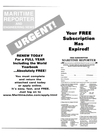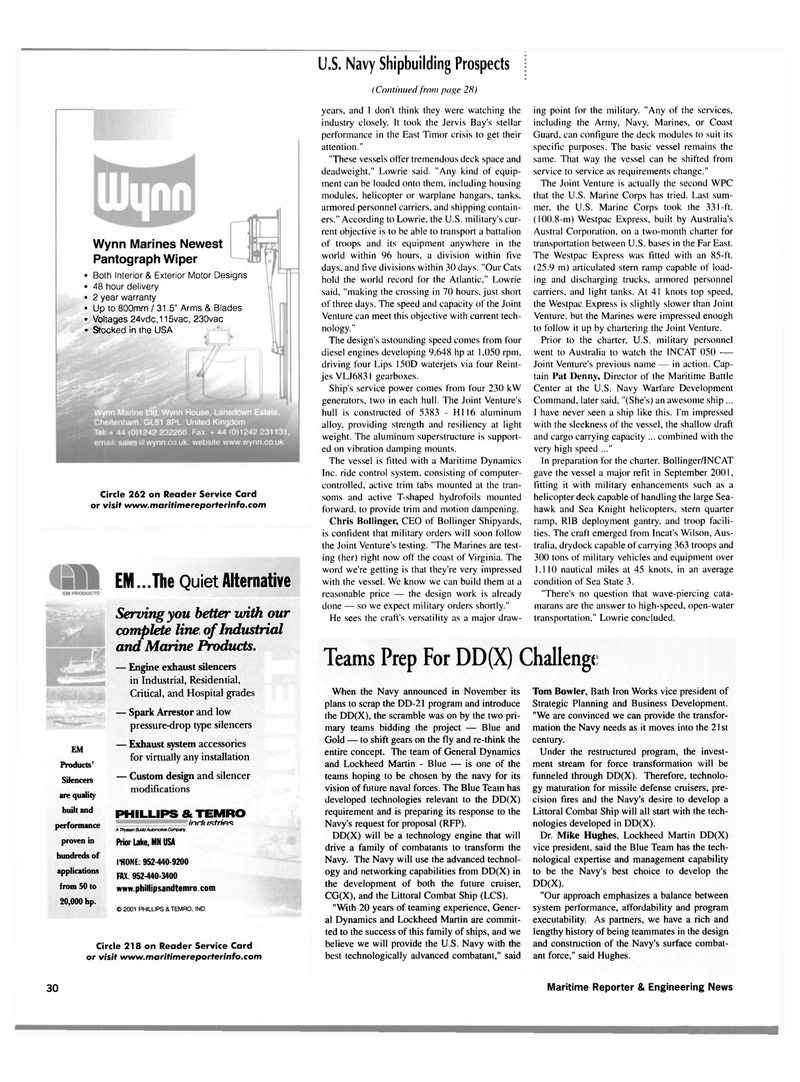
Page 33: of Maritime Reporter Magazine (January 2002)
Read this page in Pdf, Flash or Html5 edition of January 2002 Maritime Reporter Magazine
Wynn Marines Newest
Pantograph Wiper • Both Interior & Exterior Motor Designs • 48 hour delivery • 2 year warranty • Up to 800mm / 31.5" Arms & Blades • Voltages 24vdc,115vac, 230vac • Stocked in the USA
Circle 262 on Reader Service Card or visit www.maritimereporterinfo.com
EM
Products*
Silencers are quality built and performance proven in hundreds of applications from 50 to 20,000 hp.
EM...The Quiet Alternative
Serving you better with our complete line of Industrial and Marine Products. — Engine exhaust silencers in Industrial, Residential,
Critical, and Hospital grades — Spark Arrestor and low pressure-drop type silencers — Exhaust system accessories for virtually any installation — Custom design and silencer modifications
PHILLIPS & TEMRO —jnrii is;trip
ATTiyssenBuddAuamMveCorvsTy
Prior Lake, MN USA i'HON 952-440-9200
FAX 952-440-3400 www.phillipsandtemro.com © 2001 PHILLIPS & TEMRO, IND.
U.S. Navy Shipbuilding Prospects (Continued from page 28) years, and I don't think they were watching the industry closely. It took the Jervis Bay's stellar performance in the East Timor crisis to get their attention." "These vessels offer tremendous deck space and deadweight," Lowrie said. "Any kind of equip- ment can be loaded onto them, including housing modules, helicopter or warplane hangars, tanks, armored personnel carriers, and shipping contain- ers." According to Lowrie. the U.S. military's cur- rent objective is to be able to transport a battalion of troops and its equipment anywhere in the world within 96 hours, a division within five days, and five divisions within 30 days. "Our Cats hold the world record for the Atlantic," Lowrie said, "making the crossing in 70 hours, just short of three days. The speed and capacity of the Joint
Venture can meet this objective with current tech- nology."
The design's astounding speed comes from four diesel engines developing 9,648 hp at 1,050 rpm, driving four Lips 150D waterjets via four Reint- jes VLJ6831 gearboxes.
Ship's service power comes from four 230 kW generators, two in each hull. The Joint Venture's hull is constructed of 5383 - HI 16 aluminum alloy, providing strength and resiliency at light weight. The aluminum superstructure is support- ed on vibration damping mounts.
The vessel is fitted with a Maritime Dynamics
Inc. ride control system, consisting of computer- controlled, active trim tabs mounted at the tran- soms and active T-shaped hydrofoils mounted forward, to provide trim and motion dampening.
Chris Bollinger, CEO of Bollinger Shipyards, is confident that military orders will soon follow the Joint Venture's testing. "The Marines are test- ing (her) right now off the coast of Virginia. The word we're getting is that they're very impressed with the vessel. We know we can build them at a reasonable price — the design work is already done — so we expect military orders shortly."
He sees the craft's versatility as a major draw- ing point for the military. "Any of the services, including the Army, Navy, Marines, or Coast
Guard, can configure the deck modules to suit its specific purposes. The basic vessel remains the same. That way the vessel can be shifted from service to service as requirements change."
The Joint Venture is actually the second WPC that the U.S. Marine Corps has tried. Last sum- mer, the U.S. Marine Corps took the 331-ft. (100.8-m) Westpac Express, built by Australia's
Austral Corporation, on a two-month charter for transportation between U.S. bases in the Far East.
The Westpac Express was fitted with an 85-ft. (25.9 m) articulated stern ramp capable of load- ing and discharging trucks, armored personnel carriers, and light tanks. At 41 knots top speed, the Westpac Express is slightly slower than Joint
Venture, but the Marines were impressed enough to follow it up by chartering the Joint Venture.
Prior to the charter, U.S. military personnel went to Australia to watch the INCAT 050 —
Joint Venture's previous name — in action. Cap- tain Pat Denny, Director of the Maritime Battle
Center at the U.S. Navy Warfare Development
Command, later said, "(She's) an awesome ship ...
I have never seen a ship like this. I'm impressed with the sleekness of the vessel, the shallow draft and cargo carrying capacity ... combined with the very high speed ..."
In preparation for the charter, Bollinger/INCAT gave the vessel a major refit in September 2001, fitting it with military enhancements such as a helicopter deck capable of handling the large Sea- hawk and Sea Knight helicopters, stern quarter ramp, RIB deployment gantry, and troop facili- ties. The craft emerged from Incat's Wilson, Aus- tralia, drydock capable of carrying 363 troops and 300 tons of military vehicles and equipment over 1,110 nautical miles at 45 knots, in an average condition of Sea State 3. "There's no question that wave-piercing cata- marans are the answer to high-speed, open-water transportation," Lowrie concluded.
Teams Prep For DD(X) Challenge
Circle 218 on Reader Service Card or visit www.maritimereporterinfo.com
When the Navy announced in November its plans to scrap the DD-21 program and introduce the DD(X), the scramble was on by the two pri- mary teams bidding the project — Blue and
Gold — to shift gears on the fly and re-think the entire concept. The team of General Dynamics and Lockheed Martin - Blue — is one of the teams hoping to be chosen by the navy for its vision of future naval forces. The Blue Team has developed technologies relevant to the DD(X) requirement and is preparing its response to the
Navy's request for proposal (RFP).
DD(X) will be a technology engine that will drive a family of combatants to transform the
Navy. The Navy will use the advanced technol- ogy and networking capabilities from DD(X) in the development of both the future cruiser,
CG(X), and the Littoral Combat Ship (LCS). "With 20 years of teaming experience, Gener- al Dynamics and Lockheed Martin are commit- ted to the success of this family of ships, and we believe we will provide the U.S. Navy with the best technologically advanced combatant," said
Tom Bowler, Bath Iron Works vice president of
Strategic Planning and Business Development. "We are convinced we can provide the transfor- mation the Navy needs as it moves into the 21st century.
Under the restructured program, the invest- ment stream for force transformation will be funneled through DD(X). Therefore, technolo- gy maturation for missile defense cruisers, pre- cision fires and the Navy's desire to develop a
Littoral Combat Ship will all start with the tech- nologies developed in DD(X).
Dr. Mike Hughes, Lockheed Martin DD(X) vice president, said the Blue Team has the tech- nological expertise and management capability to be the Navy's best choice to develop the
DD(X). "Our approach emphasizes a balance between system performance, affordability and program executability. As partners, we have a rich and lengthy history of being teammates in the design and construction of the Navy's surface combat- ant force," said Hughes. 30 Maritime Reporter & Engineering News

 32
32

 34
34
